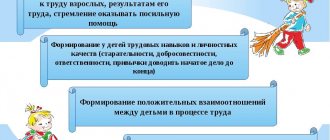Ways to organize the work of preschool children in nature
In pedagogical practice, the most common are two ways of organizing children’s work in nature.
- Individual orders. This form is the most accessible and simple. The instructions that teachers give to children help teach the child things that he is not yet familiar with. A task given to a child for individual completion creates favorable conditions for understanding and exploring his characteristics and abilities, identifying his interests and inclinations. Such assignments can be used to educate children of different preschool ages. The teacher, thanks to individual instructions, has the opportunity to help those children who need support, explain something, give advice, and monitor completed work activities. The described instructions serve as the basis for the formation of skills, responsibility for the work performed, as well as work habits.
- Teamwork. This type of work activity for preschoolers allows a large number of children to be involved in work at once. This method is used to ensure that children communicate, are able to establish collective connections and work together. In the process of working together, common work goals are formed, the ability to come to an agreement, coordinate actions with each other, draw up a work plan, and evaluate the work done. In addition, children learn about the existence of collective responsibility for the work performed. When children of the same age work together, they are able to perform a certain task, for example, cleaning a living corner. During the cleaning process, some take care of the animals, cleaning the cages, others water the flowers, and still others wipe the dust from the shelves. In such a situation, children are divided into groups.
Finished works on a similar topic
Course work Labor in nature and its role in the environmental education of preschoolers 420 ₽ Abstract Labor in nature and its role in the environmental education of preschoolers 260 ₽ Test work Labor in nature and its role in the environmental education of preschoolers 240 ₽
Receive completed work or specialist advice on your educational project Find out the cost
As another additional way of organizing work, you can consider duty. This method has a range of specific tasks, and first of all we are talking about instilling in children responsibility for the assigned work.
Types and forms of labor activity in preschool educational institutions: work in naturematerial on the topic
Municipal preschool educational institution "Kindergarten No. 217" of the Leninsky district of Saratov
I approve the Head of the MDOU “Kindergarten No. 217” __________ G.G. Pavlinova
Message to the pedagogical council on the topic:
“Types and forms of labor activity in preschool educational institutions: work in nature”
Prepared by the teacher:
Polishchuk Yu.A.
Date of:
Labor is the most important means of education, starting from preschool age; in the process, the child’s personality is formed and collective relationships are formed.
Labor is especially important for the moral education of a child. In work, independence is fostered, initiative and responsibility are developed. The goal of the entire system of labor education is the moral, psychological and practical preparation of children for conscientious work for the common benefit and the formation of the principles of hard work. In kindergarten, this goal is achieved in accordance with the age capabilities of the children, as well as the characteristics of their work activities.
Tasks of labor education of preschool children:
I. Fostering a positive attitude towards the work of adults, the desire to provide them with all possible assistance.
2. Formation of labor skills and their further improvement, gradual expansion of the content of work activity.
3. Raising positive personal qualities in children: habits of work effort, responsibility, caring, frugality,
willingness to take part in work.
4. Formation of skills for organizing your own and general work.
5. Nurturing positive relationships between children in the process of work - the ability to work cooperatively and amicably in a team, to help each other, to kindly evaluate the work of peers, to make comments and give advice in the correct form.
Types of work of preschool children
The labor activity of preschool children can be divided into four main types: self-service, household work, work caring for plants and animals, and manual labor. This division is conditional, since there are no clear boundaries between them. Each type of work activity has its own characteristics, its own purpose, its own content. This division of labor gives us the opportunity to determine the work in which it is advisable to involve preschool children, as well as their significance in the process of labor education.
Self-care – developing the skills of eating, washing, undressing and dressing; development of skills in using hygiene items (potty, handkerchief, towel, toothbrush, comb, clothes brush, etc.); fostering a caring attitude towards your belongings and household items. Genetically, the child is the first to master self-service work. Its characteristic feature is its focus on oneself, and its content is the ability to serve oneself. Its social significance lies in the fact that the child frees others from serving himself.
Household work - the development of children's household labor skills in everyday life (wiping and washing toys, children's and doll furniture, washing doll and children's linen, cleaning toys and putting things in order in the room, helping parents in the kitchen. This type of work requires the ability to maintain order in the group room, at home and on the site, participate in the organization of household processes and educational activities (hang up clean towels, set the table, prepare the group room for class, etc.).
Manual labor is the independent production, or with the help of adults, of paper, cardboard, natural and waste materials of the simplest objects needed in everyday life and for a child’s games (boxes, pincushions, panels, playing material, etc.). Manual labor appears in the older group. Children make toys, boxes, bags for collecting seeds from paper, repair books, knock together or make simple toys from wood and other materials. Manual labor requires the ability to use scissors, a needle, a hacksaw, pliers, a hammer, as well as knowledge of materials.
Labor in nature is the active, feasible participation of children in working in the flower garden, vegetable garden, as well as caring for indoor plants and pets.
Labor in nature
Varied work in nature brings children a lot of joy and contributes to their all-round development. In the process of work, a love for nature and a careful attitude towards it are cultivated. Children develop an interest in work activity and a conscious, responsible attitude towards it. In a team, children learn to work together and help each other.
Working in nature has great educational value. It broadens children's horizons and creates favorable conditions for solving problems of sensory education. Working in nature, children get to know:
- with properties and qualities, states of natural objects;
- learn how to set these properties.
The teacher teaches children to focus on the properties of natural objects to perform labor actions. So, to determine whether a plant needs watering, you need to take into account its condition (elasticity, density of leaves and stem). As a result, children develop a standard idea of the properties, qualities, and states of natural objects.
In the process of working in nature, children develop knowledge:
1) about plants (properties and qualities of plants, their structure, needs, main stages of development, methods of cultivation, seasonal changes),
2) about animals (appearance, needs, methods of movement, habits, lifestyle, seasonal changes). Children learn to make connections between conditions, the way an animal lives in nature and ways to care for it.
Working in nature contributes to the development of children's: observation skills; curiosity; inquisitiveness; arouses their interest in natural objects and human labor; respect for working people.
In the process of work, the following are formed: practical skills in caring for plants and animals; intellectual skills develop: planning work, selecting materials and tools; outline the sequence of operations, distribute them over time and between labor participants.
Requirements for the organization of labor in nature.
Work in nature only has educational significance if its organization and content meet certain pedagogical and hygienic requirements.
Pedagogical requirements for the organization of work in nature.
- Organization of work varied in content:
a) caring for animals (birds, fish, mammals), plants;
b) growing plants in a corner of nature,
c) work on the site (in the flower garden, in the vegetable garden, in the orchard).
- In the process of work, it is necessary to develop practical skills and abilities in unity with knowledge.
- Awareness of work, which involves disclosing to the child its goals, results and ways to achieve them.
- The work activities of children in nature should systematically become more complicated.
- Work activity must be regular. It is important for the teacher to introduce every child to it.
Hygienic requirements for the organization of work in nature.
- The work of children in nature should be feasible. The physical effort expended by the child should not cause overwork.
- It is necessary to ensure the correct posture of children when working. To this end, you should alternate one type of work with another.
- Tools must be absolutely safe and match the child’s height and strength, but at the same time, the equipment must be real.
Forms of labor organization in nature.
The work of children in nature is organized in the following forms:
Individual assignments - used in all age groups of the kindergarten; the child performs the entire labor process himself.
Collective work in nature makes it possible to develop work skills and abilities in all children in the group. Collective work unites children, develops the ability to accept a common goal of work, negotiate, etc.
In terms of its structure, collective work can be organized as:
a) general labor; b) joint work.
Duty - involves children alternately performing a constant and specific range of duties. In the corner of nature, children begin to be on duty in the older group.
Contents of work and management methods in different age groups
Junior group
The kids help the teacher care for the plants in the corner of nature and on the site. They should be involved in joint watering of indoor plants. He teaches children how to properly water plants and wipe the strong, leathery leaves with a damp cloth. Children plant bulbs and large seeds in the ground prepared by the teacher (in boxes, cups, soil), and water the plantings. Children should also be involved in harvesting vegetables.
Children carry out individual assignments, which include 1-2 labor operations. This work is short-term, but the teacher must involve all children in it one by one.
In the second younger group, it is possible to organize the work of the entire group of children, and for example, planting onions, large flower seeds, harvesting, this work will be organized as work nearby.
Work in subgroups is possible. Two subgroups can work at the same time, but each performs the same labor operation: wiping plants, planting peas in a garden bed, or watering a flowerbed. This feature of the organization of work is associated, firstly, with the great imitation of children, and secondly, with the fact that it is easier for the teacher to teach them. Teaching labor skills in nature in the younger group is characterized by a fragmented demonstration of a labor operation with the simultaneous completion of tasks by children. The teacher combines demonstration with explanation, and the children immediately carry out the labor process step by step.
Children's work takes place with the participation of a teacher or under his supervision. During the course, the teacher helps the children, encourages them, and shows them how to complete the task. The assessment is always positive and educational in nature.
Middle group.
In the middle group, the forms of organization of children in the labor process are the same as in the younger group. Individual assignments occupy a large place, but they are longer in nature. Children can run errands for 2-3 days. Working in subgroups also has its own characteristics. 2-3 subgroups can work simultaneously and perform different labor operations (no more than two).
Collective forms of labor occupy a large place. The teacher mainly uses them when it is necessary to introduce children to new work operations, for example, the method of planting seeds.
Children of the fifth year of life begin to develop a conscious attitude towards performing labor operations, the ability to see and feel the need to carry out one or another labor process is formed.
All these features of children’s development are the basis for complicating the methods of managing their work. When teaching a new labor operation, the teacher in the middle group no longer gives fractional demonstrations. The entire process is shown and explained, and then divided into logical steps. The teacher checks the completion of each stage. As the work progresses, he reminds of the sequence of actions, ways of using equipment, uses demonstration, example of other children when helping individual children. Now, the assessment of labor may not always be positive, since the quality of the work operation is assessed. The teacher gives an assessment as the children work and immediately offers to correct mistakes, if any. Gradually, in the middle group, the teacher teaches children to notice the need for work.
Senior preschool age
Pupils of senior preschool age, under the guidance of a teacher, continue to care for indoor plants: watering, loosening the soil, cutting off dry leaves, feeding plants, becoming familiar with methods of propagation, and helping to replant plants. In a corner of nature, in a vegetable garden and flower garden, they grow plants: they participate in digging the earth and cutting up beds and flower beds, sow seeds, plant seedlings, some of which they can grow in a corner of nature, and then water, weed, loosen the soil, and harvest. Children need to develop appropriate labor skills and abilities, teach them to determine the need for one or another method of care based on the condition of plants and soil, and establish a connection between the condition of plants and human labor aimed at meeting the needs of plants.
Pupils of the preparatory group provide care independently. The teacher only controls their actions and provides assistance in case of difficulty. At the same time, it is necessary to develop an understanding of the need for a method of care, the ability to establish a connection between the conditions that need to be created in a corner of nature for animals, and the conditions of their existence in nature.
Mastery of labor activity in senior and pre-school groups occurs in more complex forms of labor organization. At this age, it is necessary to develop the ability to accept and set a work task, present the result of its implementation, determine the sequence of work operations, select the necessary material, and independently carry out the work process with a little help from adults. Individual assignments for the care of individual objects are becoming longer. A child can be entrusted with growing a plant as a gift for children, mother, or caring for a garden bed or flower bed.
In the older group, children are on duty in a corner of nature. When organizing duty, the teacher conducts a lesson in which he introduces children to the responsibilities of those on duty. 2-4 people are on duty at the same time.
Duty assessment plays a major role in managing the work of duty officers. All children are involved in the assessment. Children evaluate the work performed by those on duty, express judgments about its quality, about their attitude towards responsibilities and towards each other in the process of work. When assessing, one should also note the negative manifestations of the attendants (arrived late, did not have time to water the plants).
There is also the most complex type of collective labor—joint labor. Work in the vegetable garden and flower garden can be organized according to this type. One subgroup digs up the beds, another loosens the ground, the third makes furrows and sows seeds. This form of labor organization creates objective conditions for the emergence of relationships determined by the very structure of the organization.
When organizing collective work, the teacher helps children break into units, distribute responsibilities between units and within units. Observing the work of children, the teacher helps them, gives advice and instructions.
The leading method of teaching children new work is to explain what needs to be done and how. Demonstration of methods of action also takes place and is used mainly when becoming familiar with a new work operation.
In the process of supervising children’s work, the task is to develop control and self-control: the teacher, checking the completion of the task, asks individual children questions that direct their attention to the result of the work. This technique develops self-control and the ability to correlate one’s actions with the instructions of the teacher.
The assessment is positive, but it is differentiated by quality: “I planted it correctly, but I didn’t press the soil around the bulb well.” The children themselves are also involved in the assessment. A feature of work management in the senior and pre-school groups is that the teacher discusses the work process with the children. He teaches children not only to see, but also to plan the sequence of individual work operations, distribute responsibilities in advance, and independently prepare all the equipment.
Conclusion
The labor education of a child begins with the formation in the family and school of elementary ideas about labor responsibilities. Labor has been and remains a necessary and important means of developing the psyche and moral ideas of the individual.
In the process of work, a preschooler has the opportunity to put his knowledge into practice, acquire new ones, and clearly see the existence of various relationships in nature (plants, animals, and the environment). He develops the necessary care skills and a sense of responsibility for living organisms.
Depending on the preschooler’s attitude towards work, one can judge the development of his moral qualities, i.e. the child’s attitude towards the worker (respect for him, desire to help, etc.), towards his work (conscientious attitude towards the results of labor, etc. . p.), which is an indicator of the formation and development of his moral qualities.
Bibliography
- Bure R.S. Preschooler and work. Theory and methodology of labor education. – M.: Mosaika-Sintez, 2011.
- Godina G.N. Nurturing a positive attitude towards work // Education of moral feelings in older preschoolers / Ed. A.M. Vinogradova. M.: Education, 1998.
- Kozlova S.A. Kulikova T.A. Preschool pedagogy. - M., 2004.
- Komarova, Kutsakova, Pavlova: Labor education in kindergarten. Program and methodological recommendations. – M.: Mosaika-Sintez, 2009.
- Kutsakova L.V. “Moral and labor education of a preschool child: program and methodological manual” - M.: Vlados, 2005.
- Kutsakova L.V. Moral and labor education in kindergarten: for working with children 3-7 years old: [methodological manual]. – M.: Mosaika-Sintez, 2007.
- Markova T. A. Cultivating hard work in preschoolers. - M., 1991.
- Moral and labor education of preschool children: Proc. aid for students higher ped. textbook institutions / S. A. Kozlova, N. K. Dedovskikh, V. D. Kalishenko and others; Ed. S. A. Kozlova. - M.: Publishing House, 2002.
The importance of work in nature for environmental education of preschool children
Work in nature becomes quite important in the environmental education of preschool children. In the process of such work, children are instilled with the qualities of a caring and respectful attitude towards nature.
The role of labor in nature is to create good conditions for nurturing the sensory characteristics of children. They learn to focus on the distinctive features of objects in achieving the desired results and goals. For example, to understand whether a plant needs watering, it is worth assessing its condition - lethargy of the stem and leaves, elasticity of the leaves, etc.
Are you an expert in this subject area? We invite you to become the author of the Directory Working Conditions
When children care for animals, they become aware of the peculiarities of their behavior depending on the conditions in which they live and what they need to be fed. Understanding such relationships shapes their more meaningful attitude towards work. They develop an interest in it, and then a stable work ethic is formed.
Working in nature can be considered as one of the methods that helps develop children's powers of observation.
In addition to education, work also influences the learning process of preschoolers. Thus, children develop an idea of what objects of labor are, their properties, needs, structure, their development, animals and their habitats, methods of caring for them, etc.



